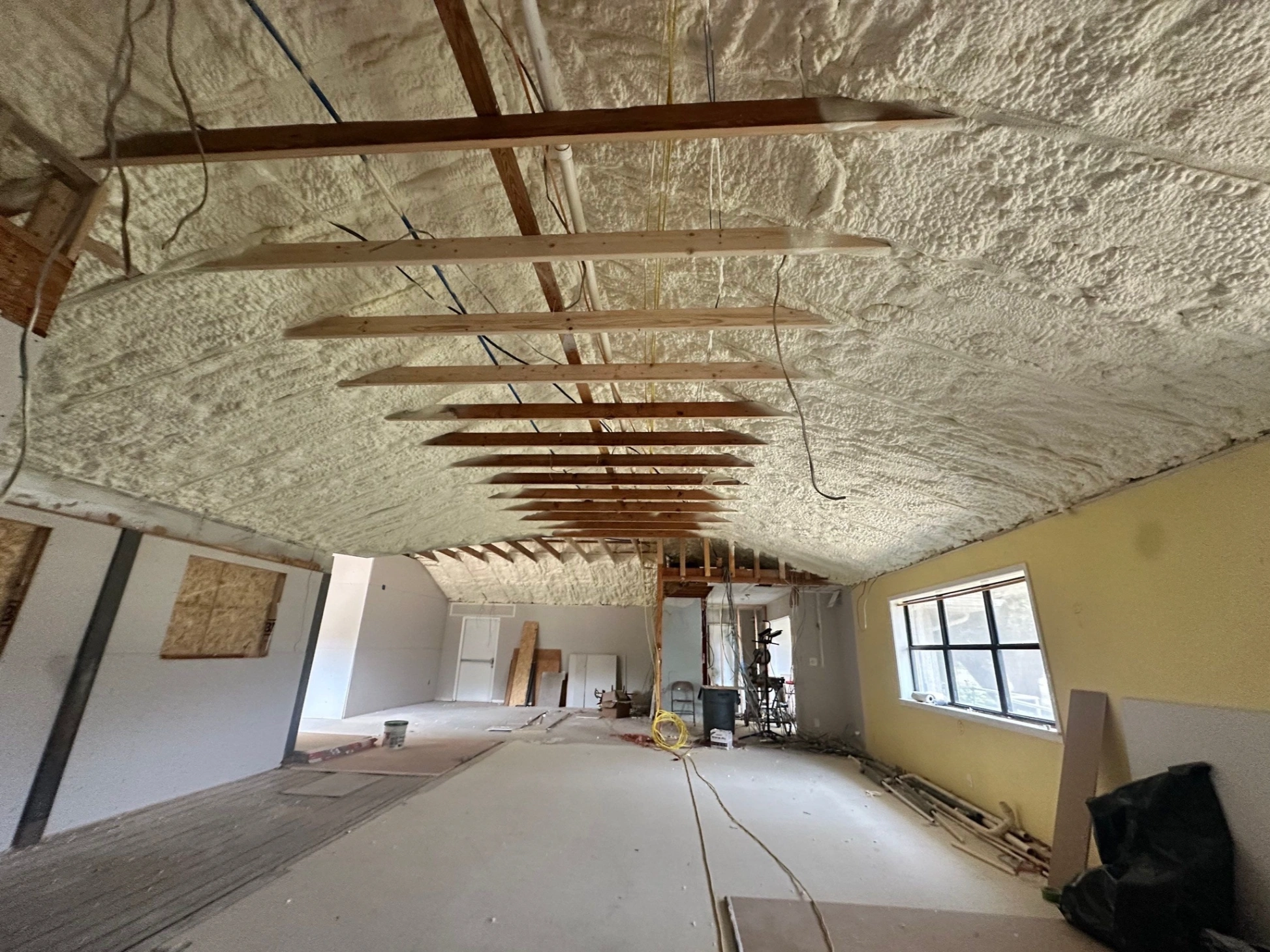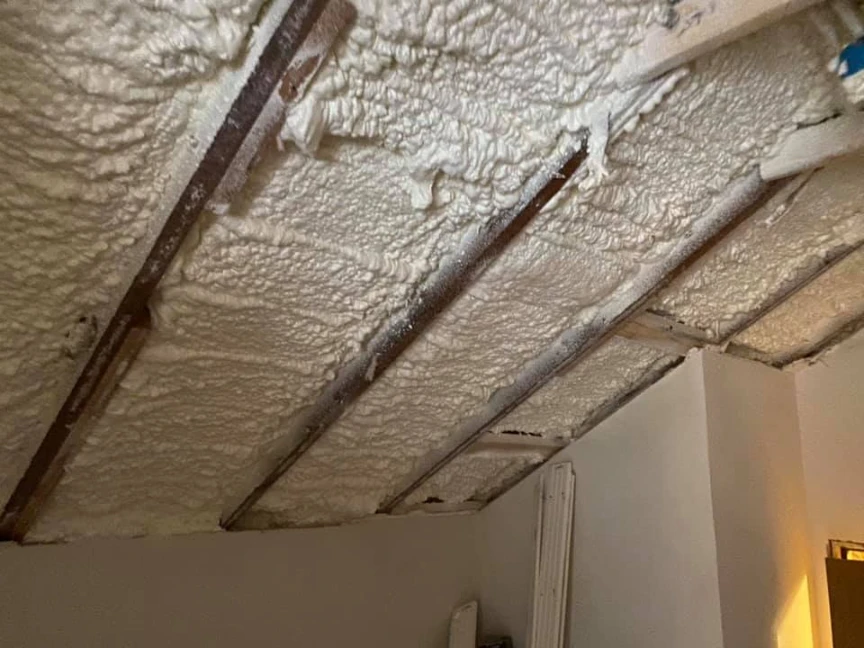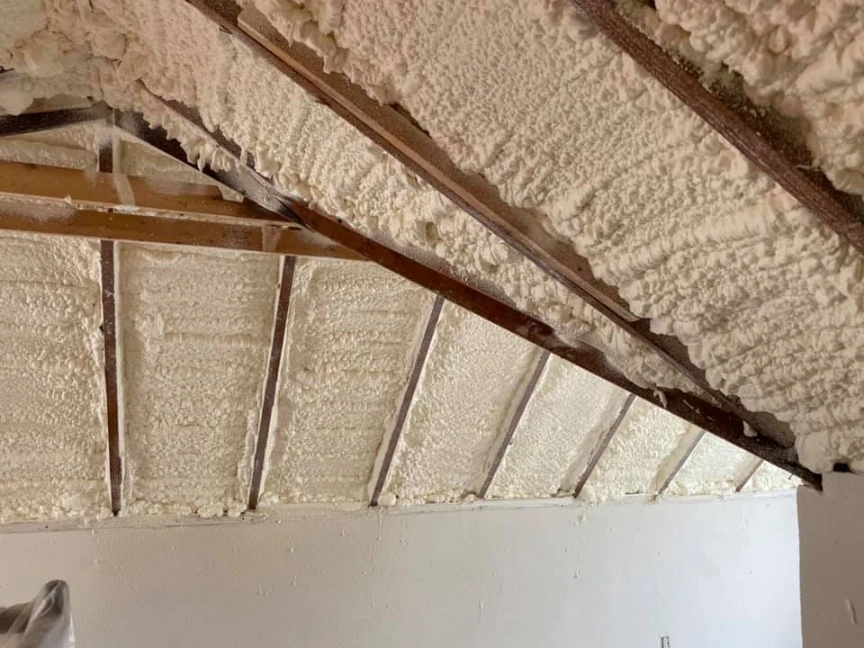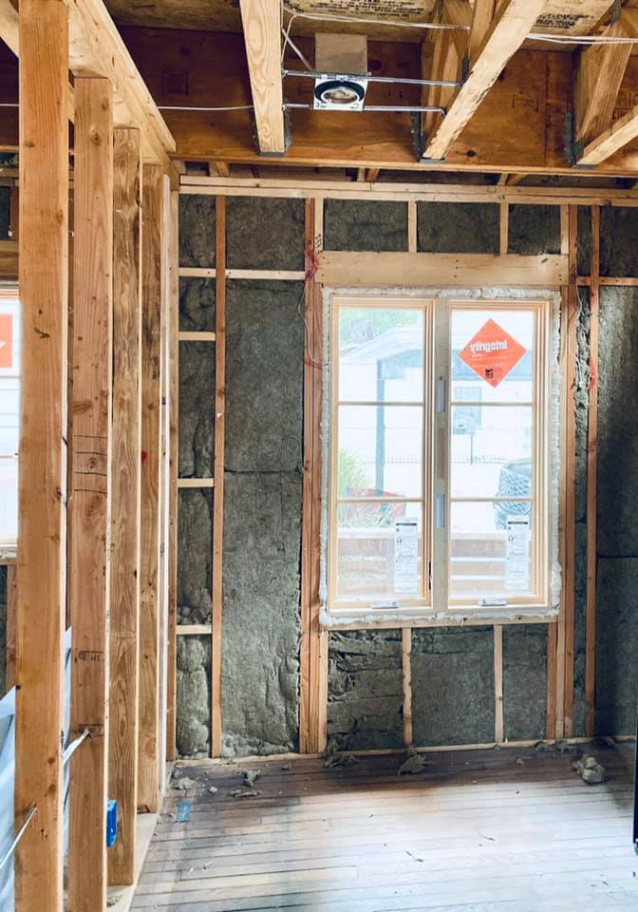In the world of commercial construction and property management, energy efficiency, durability, and long-term operating costs are paramount. As building standards evolve and energy prices continue to fluctuate, the demand for high-performance building materials has never been greater. One of the most significant advancements in building envelope technology is spray polyurethane foam (SPF) insulation. This innovative material offers a powerful solution for creating airtight, well-insulated, and resilient commercial structures, from warehouses and retail spaces to office buildings and industrial facilities.
However, navigating the world of commercial spray foam insulation can be complex. With different types of foam, specific application requirements, and a range of building code considerations, making an informed decision requires a deep understanding of the technology. This comprehensive guide serves as a definitive resource, drawing from years of hands-on experience in the insulation industry. Here, you will find a top-to-bottom exploration of everything you need to know about leveraging spray foam insulation for your commercial property.
Understanding Commercial Spray Foam Insulation
Spray polyurethane foam (SPF) is a type of plastic that is created on-site by mixing two liquid components. When these liquids are combined, they react and expand rapidly to create a foam that insulates, air seals, and can even provide moisture and vapor barriers. Unlike traditional insulation materials like fiberglass or cellulose, which come in pre-cut batts or are blown into cavities, spray foam is applied as a liquid that expands to fill every crack, crevice, and gap, creating a continuous and seamless barrier. This monolithic seal is one of the primary reasons SPF is so effective in commercial buildings.
Why It Matters for Commercial Buildings
Commercial properties, with their large surface areas, complex layouts, and high energy demands, present unique insulation challenges. Traditional insulation often leaves gaps and seams, leading to air leakage and thermal bridging, where heat can bypass the insulation. This forces HVAC systems to work harder to maintain consistent indoor temperatures, resulting in significant energy waste. According to the U.S. Department of Energy, HVAC systems can account for up to 40% of energy use in commercial properties.
Spray foam insulation directly addresses these issues by creating an airtight building envelope. This dramatically reduces heat transfer and air infiltration, leading to substantial energy savings of 30-50% on heating and cooling costs. Furthermore, its ability to adhere to various substrates, including metal, concrete, and wood, makes it a versatile solution for a wide range of commercial construction types.
Market Growth and Industry Trends
The effectiveness of spray foam insulation has not gone unnoticed. A market analysis from Future Market Insights shows the global spray foam insulation market is projected to grow significantly, driven by stringent government regulations aimed at reducing greenhouse gas emissions and increasing energy efficiency in buildings. As sustainability and green building practices become more prevalent, the demand for high-performance insulation solutions like spray foam is expected to continue its upward trend.
The Two Types of Commercial Spray Foam: Open-Cell vs. Closed-Cell
Spray foam insulation is broadly categorized into two types: open-cell and closed-cell. While both provide insulation and air sealing, their distinct physical properties make them suitable for different applications. Understanding these differences is essential for specifying the right product for your commercial project.
Open-Cell Spray Foam
Open-cell spray foam, also known as low-density foam, has a cell structure where the tiny bubbles within the foam are not completely sealed. This makes the foam softer, more flexible, and lighter, with a typical density of about 0.5 pounds per cubic foot. During application, it expands significantly, often up to 120 times its initial volume, making it excellent for filling large or irregularly shaped cavities.
Key Characteristics of Open-Cell Foam:
- R-Value: The thermal resistance, or R-value, of open-cell foam is typically around R-3.5 to R-4.5 per inch.
- Air Barrier: It creates an effective air barrier, preventing drafts and air leakage.
- Sound Dampening: The porous nature of open-cell foam makes it an excellent sound absorbent, reducing noise transmission between rooms and from the outside.
- Vapor Permeability: Open-cell foam is vapor-permeable, meaning it allows water vapor to pass through it. This can be beneficial in some climates as it allows the building assembly to breathe and dry out. However, it is not suitable for applications where it may come into direct contact with water.
Best Applications for Open-Cell Foam:
- Interior walls for soundproofing
- Attic roof decks and ceilings in climate zones where vapor barriers are not required
- Filling large, unobstructed cavities
Closed-Cell Spray Foam
Closed-cell spray foam, or medium-density foam, is composed of tiny, uniform cells that are completely enclosed and packed tightly together. These cells are filled with a gas that helps the foam achieve a higher R-value. With a density of around 2 pounds per cubic foot, closed-cell foam is rigid, strong, and provides a much more robust barrier.
Key Characteristics of Closed-Cell Foam:
- High R-Value: Closed-cell foam offers a superior R-value, typically ranging from R-6.0 to R-7.5 per inch. This provides more insulating power in less space.
- Air and Vapor Barrier: Its closed-cell structure makes it impermeable to both air and water vapor, creating an all-in-one insulation, air barrier, and moisture barrier.
- Structural Strength: The rigid nature of closed-cell foam adds structural reinforcement to the building assembly, increasing its durability and resistance to high winds and heavy snow loads.
- Moisture Resistance: It is highly resistant to water, making it ideal for applications in flood-prone areas, below-grade, and on commercial roofs.
Best Applications for Closed-Cell Foam:
- Exterior walls and continuous exterior insulation
- Commercial roofing systems
- Metal buildings to prevent condensation
- Below-grade applications, such as basements and crawl spaces
- Cold storage facilities
Comparison Table: Open-Cell vs. Closed-Cell Spray Foam
| Feature | Open-Cell Spray Foam | Closed-Cell Spray Foam |
|---|---|---|
| R-Value per Inch | R-3.5 – R-4.5 | R-6.0 – R-7.5 |
| Density | Low (0.5 lb/ft³) | Medium (2.0 lb/ft³) |
| Air Barrier | Yes | Yes |
| Vapor Barrier | No (Permeable) | Yes (Impermeable) |
| Structural Strength | No | Yes (Adds rigidity) |
| Sound Dampening | Excellent | Good |
| Expansion Rate | High | Moderate |
| Cost | Lower | Higher |
Key Takeaways
Choosing between open-cell and closed-cell spray foam depends on the specific requirements of the application. Open-cell is a cost-effective choice for interior applications where sound dampening is a priority. Closed-cell foam provides a higher R-value, superior moisture resistance, and added structural strength, making it the preferred option for exterior walls, roofs, and demanding environments.
The Commercial Spray Foam Installation Process
Proper installation is critical to achieving the maximum benefits of spray foam insulation. It is a complex process that requires specialized equipment and certified professionals to ensure safety and performance. The installation process can be broken down into four main stages: preparation, application, curing, and cleanup.
Stage 1: Assessment and Preparation
Before any foam is sprayed, a thorough assessment of the commercial property is conducted. This includes identifying all areas to be insulated, measuring the square footage, and determining the appropriate type and thickness of foam required to meet building codes and performance goals.
The preparation phase is extensive and foundational for a successful application:
- Clearing the Area: All obstacles, equipment, and materials must be removed from the application area to provide clear access for the installation crew and their scaffolding or lifts.
- Protecting Surfaces: Any surfaces that are not being insulated, such as windows, doors, flooring, and HVAC equipment, are carefully covered with plastic sheeting and tape to protect them from overspray.
- Ensuring a Clean Substrate: The surfaces to be sprayed must be clean, dry, and free of any oil, dust, or debris that could interfere with the foam’s adhesion.
- Safety Measures: The work site must be made safe and compliant with OSHA standards, including the installation of safety railings around open areas like stairwells.
Expert Tip: Ensure that all other trade work, such as HVAC, plumbing, and electrical installations, is completed before the insulation team arrives. Spray foam will fill all available space, so any necessary systems must be in place first.
Stage 2: Application
The application of spray foam is a precise process performed by trained technicians. High-pressure spray foam is typically applied using a spray rig, which is a truck or trailer that houses the two liquid components, an air supply, and hoses that can extend up to 300 feet to reach the application area.
The technicians, wearing appropriate personal protective equipment (PPE), use a spray gun to mix the two components at the nozzle. The liquid mixture is then sprayed onto the substrate in even, continuous motions. For large commercial projects, it is common to spray the roof deck first before moving on to the walls. This is because the roof often requires the most extensive prep work, and it prevents overspray from the ceiling from landing on newly insulated walls.
Stage 3: Curing and Cleanup
As soon as the foam is applied, it begins to expand and solidify. The curing time can vary depending on the type of foam, thickness, and ambient conditions, but it generally hardens quickly. Once the foam has cured, the cleanup process begins.
This involves removing all of the protective plastic and tape from windows, doors, and other fixtures. Any overspray is carefully trimmed away, and the entire work area is cleaned.
Stage 4: Post-Installation Walkthrough
A reputable contractor will conduct a final walkthrough with the property owner or manager to inspect the completed work. This is an opportunity to ensure that the insulation has been applied to the correct thickness and that the cleanup meets expectations. Addressing any potential issues while the crew is still on-site is far more efficient than discovering them later.
The Transformative Benefits of Spray Foam in Commercial Properties
Investing in spray foam insulation for a commercial building yields a multitude of long-term benefits that go far beyond simple temperature regulation. These advantages contribute to lower operating costs, a healthier indoor environment, and a more durable and valuable property.
1. Unmatched Energy Efficiency
The primary benefit of spray foam insulation is its superior thermal performance. By creating a seamless, airtight seal, it significantly reduces air leakage, which is a major source of energy loss in commercial buildings. This airtightness allows HVAC systems to operate more efficiently, often leading to a reduction in heating and cooling costs by 30% or more. The high R-value of closed-cell foam, in particular, provides maximum insulation with minimal thickness, making it an ideal solution for achieving high energy efficiency standards.
2. Enhanced Structural Integrity
Closed-cell spray foam is incredibly dense and rigid, and it adheres tenaciously to the surfaces it is applied to. This adds significant structural strength to walls and roof decks, helping them better withstand external forces such as high winds and heavy snow loads. This added durability is especially valuable for large commercial and industrial buildings, as well as for retrofitting older structures.
3. Superior Moisture and Condensation Control
Moisture intrusion can lead to a host of problems in commercial buildings, including mold growth, mildew, and structural rot. Closed-cell spray foam acts as a robust moisture barrier, preventing water from infiltrating the building envelope. In metal buildings, a common issue is condensation forming on the interior of the metal panels. A layer of closed-cell spray foam keeps the interior surface of the panels warm, preventing moisture from condensing and protecting both the building and its contents.
Expert Tip: For metal buildings, even a 1-inch layer of closed-cell spray foam can be sufficient to stop condensation, while a thicker application is recommended for full thermal insulation.
4. Improved Indoor Air Quality
By sealing the building envelope, spray foam reduces the infiltration of outdoor allergens, pollutants, and dust. Its moisture-resistant properties also inhibit the growth of mold and mildew, which are common triggers for respiratory issues. This creates a cleaner, healthier indoor environment for employees, customers, and tenants.
5. Long-Term Durability and Low Maintenance
Unlike traditional insulation materials that can sag, settle, or degrade over time, spray foam maintains its shape and performance for the life of the building. Once installed, it is a permanent solution that requires virtually no maintenance, providing long-term value and peace of mind.
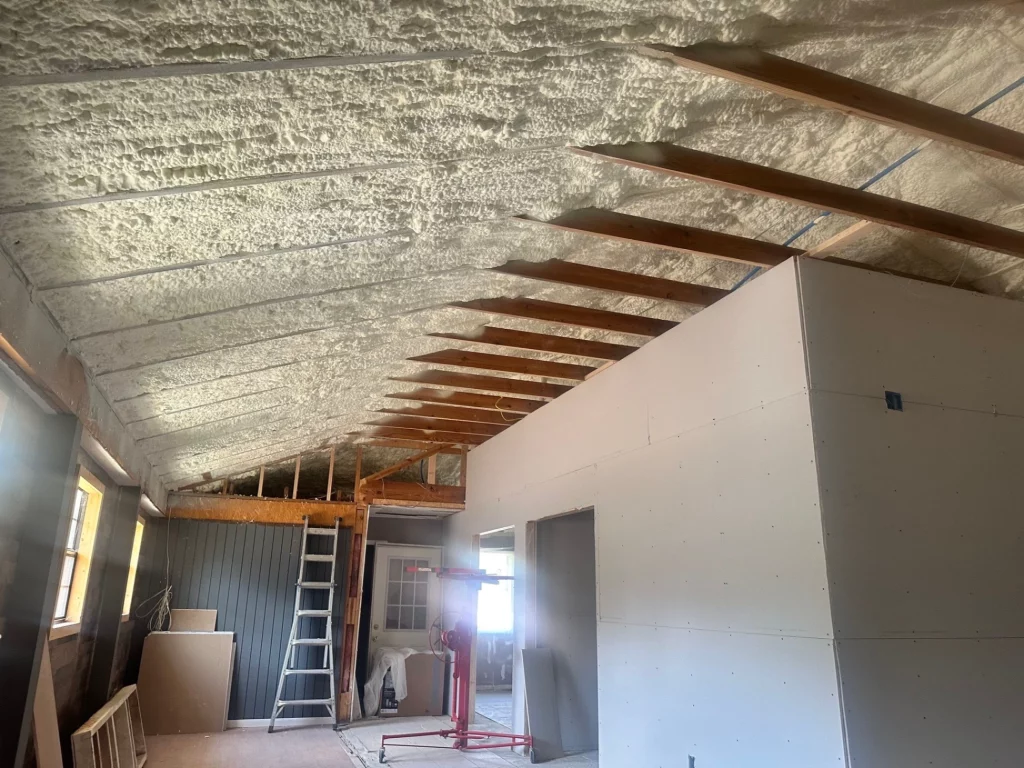
Meeting Building Codes and Embracing Sustainable Construction
The use of spray foam insulation in commercial buildings is governed by a set of codes and standards to ensure safety and performance. Additionally, its energy-saving properties make it a valuable component in green building certifications like LEED.
Navigating Commercial Building Codes
Commercial insulation projects must comply with regulations at the federal, state, and local levels. The primary codes that impact spray foam insulation include:
- International Building Code (IBC): This code governs most commercial construction and includes specific requirements for foam plastic insulation related to fire safety.
- International Energy Conservation Code (IECC): The IECC sets minimum R-value requirements for different parts of the building envelope based on climate zone.
- National Fire Protection Association (NFPA) Regulations: These standards provide further guidelines for fire safety.
According to the Spray Polyurethane Foam Alliance (SPFA), one of the most important requirements of the IBC is the use of a thermal barrier. In most applications, spray foam insulation must be separated from the interior of the building by a 15-minute thermal barrier, such as 1/2-inch gypsum board (drywall), to delay the spread of flames in the event of a fire. In some cases, an intumescent coating, which is a special fire-retardant paint, can be used as an alternative.
Expert Tip: Always have the ASTM E84 documentation, which details the flame spread and smoke development characteristics of the foam, available on-site for building inspectors.
Spray Foam and LEED Certification
Leadership in Energy and Environmental Design (LEED) is a globally recognized green building certification program. High-performance insulation like spray foam can contribute to earning points toward LEED certification in several categories:
- Energy and Atmosphere (EA): By significantly improving the energy efficiency of the building, spray foam helps optimize energy performance, which is a major component of this category.
- Indoor Environmental Quality (EQ): Spray foam contributes to better indoor air quality by sealing the building from outside pollutants and preventing mold growth. It also enhances thermal comfort for occupants.
- Materials and Resources (MR): Some spray foam products contain recycled or bio-based content, which can contribute to points in this category.
The use of spray foam is a clear step toward creating more sustainable and environmentally responsible commercial buildings.
The Future of Commercial Spray Foam Insulation
The spray foam industry is continually evolving, with a focus on creating more environmentally friendly and technologically advanced products. One of the key trends is the shift toward low-Global Warming Potential (GWP) blowing agents. These next-generation blowing agents reduce the environmental impact of the foam without compromising its performance.
Another area of development is the integration of spray foam with smart building technologies. This could involve embedding sensors within the insulation to monitor energy use and indoor air quality in real-time, allowing for even greater optimization of building performance. As the focus on energy efficiency and sustainable construction intensifies, spray foam insulation is poised to play an even greater role in the future of commercial buildings.
Key Takeaways
Commercial spray foam insulation is a multifaceted solution that offers significant advantages in energy efficiency, structural durability, and moisture control. By understanding the differences between open-cell and closed-cell foam, adhering to proper installation procedures, and complying with building codes, property owners can make a wise investment that delivers returns for decades.
Putting Your Commercial Spray Foam Strategy into Action
You now have a comprehensive understanding of commercial spray foam insulation, from its fundamental properties to its advanced applications. This guide has walked you through the critical distinctions between open-cell and closed-cell foam, the detailed installation process, and the extensive benefits that this technology brings to a commercial property. You have also learned about the importance of adhering to building codes and how spray foam aligns with modern sustainable construction practices.
The decision to insulate a commercial building is not just about meeting minimum requirements; it is a strategic investment in the long-term performance, efficiency, and value of your property. By creating a superior thermal envelope, you can significantly reduce operating costs, enhance the comfort and health of the indoor environment, and fortify the structure against the elements. As you move forward, use this guide as a reference to help you make informed choices and to communicate effectively with architects, contractors, and insulation professionals.
Need Expert Guidance?
Navigating the specifics of a commercial insulation project requires a deep level of expertise. If you have questions about your property or need a professional consultation to determine the best insulation strategy, the team at Stellrr Insulation & Spray Foam is here to help. With extensive experience in commercial applications, we can provide the insights and quality installation your project deserves. Contact us at (512) 710-2839 to discuss your needs.
Sources
- Future Market Insights: This market report offers a detailed analysis of the global spray foam insulation market, including forecasts, trends, and key growth drivers.
- Spray Polyurethane Foam Alliance (SPFA): The SPFA is the main trade association for the spray foam industry and provides extensive resources on the application of SPF in commercial buildings, including code compliance.
- U.S. Department of Energy: The Department of Energy provides data and information on energy consumption in various sectors, including statistic on HVAC energy use in commercial buildings.
Frequently Asked Questions About Commercial Spray Foam Insulation
What is the typical cost of commercial spray foam insulation?
The cost of commercial spray foam insulation can vary widely based on the type of foam used (closed-cell is more expensive than open-cell), the thickness required, the size of the project, and the complexity of the application. While the initial investment is higher than for traditional insulation, the long-term energy savings often result in a payback period of just a few years.
How long does spray foam insulation last in a commercial building?
When installed correctly, spray foam insulation should last for the entire lifespan of the building. It does not sag, settle, or degrade over time like other insulation materials, making it a permanent solution.
Is spray foam insulation a fire hazard?
Spray polyurethane foam is a combustible material, which is why building codes require it to be covered by a thermal barrier, such as drywall, in most applications. This barrier is designed to slow the spread of flames in a fire. When installed in compliance with these codes, spray foam is a safe and effective insulation material.
Can spray foam be applied to an existing commercial building?
Yes, spray foam is an excellent choice for retrofitting existing commercial buildings. It can be applied to the interior of walls, to the underside of roof decks, and in crawl spaces to dramatically improve the energy efficiency and comfort of an older structure.
How does spray foam perform in metal buildings?
Spray foam is considered one of the best insulation options for metal buildings. Closed-cell spray foam adheres directly to the metal panels, creating an airtight seal that regulates temperature and, most importantly, prevents condensation from forming on the interior surfaces. This protects the building from moisture damage and corrosion.
Is spray foam insulation environmentally friendly?
Spray foam insulation contributes to a greener environment primarily by reducing a building’s energy consumption, which in turn lowers its carbon footprint. The industry is also moving toward using blowing agents with lower global warming potential. Many products are available that are low-VOC and do not contain ozone-depleting substances.


